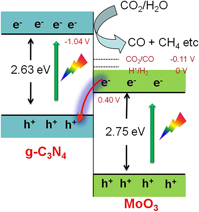Crossref Citations
This article has been cited by the following publications. This list is generated based on data provided by
Crossref.
Wang, Shuaijun
He, Fengting
Dong, Pei
Tai, Zhaoxin
Zhao, Chaocheng
Wang, Yongqiang
Liu, Fang
and
Li, Lin
2018.
Simultaneous morphology, band structure, and defect optimization of graphitic carbon nitride microsphere by the precursor concentration to boost photocatalytic activity.
Journal of Materials Research,
Vol. 33,
Issue. 23,
p.
3917.
Wang, Mengjun
Liu, Chao
Zhang, Xiaobo
Fan, Zichun
Xu, Jiasheng
and
Tong, Zhiwei
2018.
In situ synthesis of CsTi2NbO7@g-C3N4 core–shell heterojunction with excellent electrocatalytic performance for the detection of nitrite.
Journal of Materials Research,
Vol. 33,
Issue. 23,
p.
3936.
Song, Yiming
Li, Jun
and
Wang, Chen
2018.
Modification of porphyrin/dipyridine metal complexes on the surface of TiO2 nanotubes with enhanced photocatalytic activity for photoreduction of CO2 into methanol.
Journal of Materials Research,
Vol. 33,
Issue. 17,
p.
2612.
Wang, Jie
Ren, LiZhen
Zhang, DongEn
Hao, XiaoYun
Gong, JunYan
Xiao, Xin
Jiang, YouXiang
and
Tong, ZhiWei
2018.
Fabrication of Bi2MoO6/BiOI heterojunction photocatalysts for enhanced photodegradation of RhB.
Journal of Materials Research,
Vol. 33,
Issue. 23,
p.
3928.
Liu, Shuilian
Chen, Jianlin
Xu, Difa
Zhang, Xiangchao
and
Shen, Mengyao
2018.
Enhanced photocatalytic activity of directZ-scheme Bi2O3/g-C3N4composites via facile one-step fabrication.
Journal of Materials Research,
Vol. 33,
Issue. 10,
p.
1391.
Kumar, Santosh
Karthikeyan, Sekar
and
Lee, Adam
2018.
g-C3N4-Based Nanomaterials for Visible Light-Driven Photocatalysis.
Catalysts,
Vol. 8,
Issue. 2,
p.
74.
Jiang, Xiaole
Ma, Yueying
Zhao, Chunran
Chen, Yijing
Cui, Min
Yu, Jingxiong
Wu, Ying
and
He, Yiming
2018.
Synthesis of flower-like AgI/Bi5O7I hybrid photocatalysts with enhanced photocatalytic activity in rhodamine B degradation.
Journal of Materials Research,
Vol. 33,
Issue. 16,
p.
2385.
Shen, Meng
Zhang, Lingxia
and
Shi, Jianlin
2018.
Converting CO2 into fuels by graphitic carbon nitride-based photocatalysts.
Nanotechnology,
Vol. 29,
Issue. 41,
p.
412001.
Qiao, Qing
Yang, Ke
Ma, Li-Li
Huang, Wei-Qing
Zhou, Bing-Xin
Pan, Anlian
Hu, Wangyu
Fan, Xiaoxing
and
Huang, Gui-Fang
2018.
Facile in situ construction of mediator-free direct Z-scheme g-C3N4/CeO2 heterojunctions with highly efficient photocatalytic activity.
Journal of Physics D: Applied Physics,
Vol. 51,
Issue. 27,
p.
275302.
Wang, Yunke
Hu, Shaozheng
Li, Qiang
Gu, Guizhou
Zhao, Yanfeng
Liang, Hongyu
and
Li, Wei
2018.
One step synthesis of high-efficiency AgBr–Br–g-C3N4 composite catalysts for photocatalytic H2O2 production via two channel pathway.
RSC Advances,
Vol. 8,
Issue. 64,
p.
36903.
Ma, Yunfeng
Yang, Lili
Yang, Yong
Peng, Yusi
Wei, Yuquan
and
Huang, Zhengren
2018.
Multifunctional Ag-decorated g-C3N4 nanosheets as recyclable SERS substrates for CV and RhB detection.
RSC Advances,
Vol. 8,
Issue. 39,
p.
22095.
Wang, Meng
Peng, Zhijian
Li, Hong
Zhao, Zengying
and
Fu, Xiuli
2018.
C fibers@MoO2 nanoparticles core–shell composite: Highly efficient solar-driven photocatalyst.
Journal of Materials Research,
Vol. 33,
Issue. 6,
p.
685.
Zhang, Peng
Dong, Zhiyuan
Ran, Yuanming
Xie, Hualin
Lu, Yun
and
Ding, Shimin
2018.
Preparation and photocatalytic application of AgBr modified Bi2WO6 nanosheets with high adsorption capacity.
Journal of Materials Research,
Vol. 33,
Issue. 23,
p.
3953.
Liu, Xingqi
and
Cai, Li
2018.
Novel indirect Z-scheme photocatalyst of Ag nanoparticles and polymer polypyrrole co-modified BiOBr for photocatalytic decomposition of organic pollutants.
Applied Surface Science,
Vol. 445,
Issue. ,
p.
242.
Xue, Shengyang
Wu, Chunzheng
Pu, Shengyan
Hou, Yaqi
Tong, Tian
Yang, Guang
Qin, Zhaojun
Wang, Zhiming
and
Bao, Jiming
2019.
Direct Z-Scheme charge transfer in heterostructured MoO3/g-C3N4 photocatalysts and the generation of active radicals in photocatalytic dye degradations.
Environmental Pollution,
Vol. 250,
Issue. ,
p.
338.
Zhu, Xiaodi
and
Sun, Song
2019.
Nanophotocatalysis and Environmental Applications.
Vol. 31,
Issue. ,
p.
67.
Chen, Pengfei
Xing, Pingxing
Chen, Zhiqiang
Hu, Xin
Lin, Hongjun
Zhao, Leihong
and
He, Yiming
2019.
In-situ synthesis of AgNbO3/g-C3N4 photocatalyst via microwave heating method for efficiently photocatalytic H2 generation.
Journal of Colloid and Interface Science,
Vol. 534,
Issue. ,
p.
163.
Ma, Yajuan
Wang, Heng
Yu, Junchen
Mo, Wanling
and
Yuan, Hong
2019.
Synergetic effect of carbon self-doping and TiO2 deposition on boosting the visible-light photocatalytic hydrogen production efficiency of carbon nitride.
International Journal of Hydrogen Energy,
Vol. 44,
Issue. 12,
p.
5881.
Nguyen, Chinh-Chien
Sakar, M.
Vu, Manh-Hiep
and
Do, Trong-On
2019.
Nitrogen Vacancies-Assisted Enhanced Plasmonic Photoactivities of Au/g-C3N4 Crumpled Nanolayers: A Novel Pathway toward Efficient Solar Light-Driven Photocatalysts.
Industrial & Engineering Chemistry Research,
Vol. 58,
Issue. 9,
p.
3698.
Ghosh, Utpal
and
Pal, Anjali
2019.
Graphitic carbon nitride based Z scheme photocatalysts: Design considerations, synthesis, characterization and applications.
Journal of Industrial and Engineering Chemistry,
Vol. 79,
Issue. ,
p.
383.






